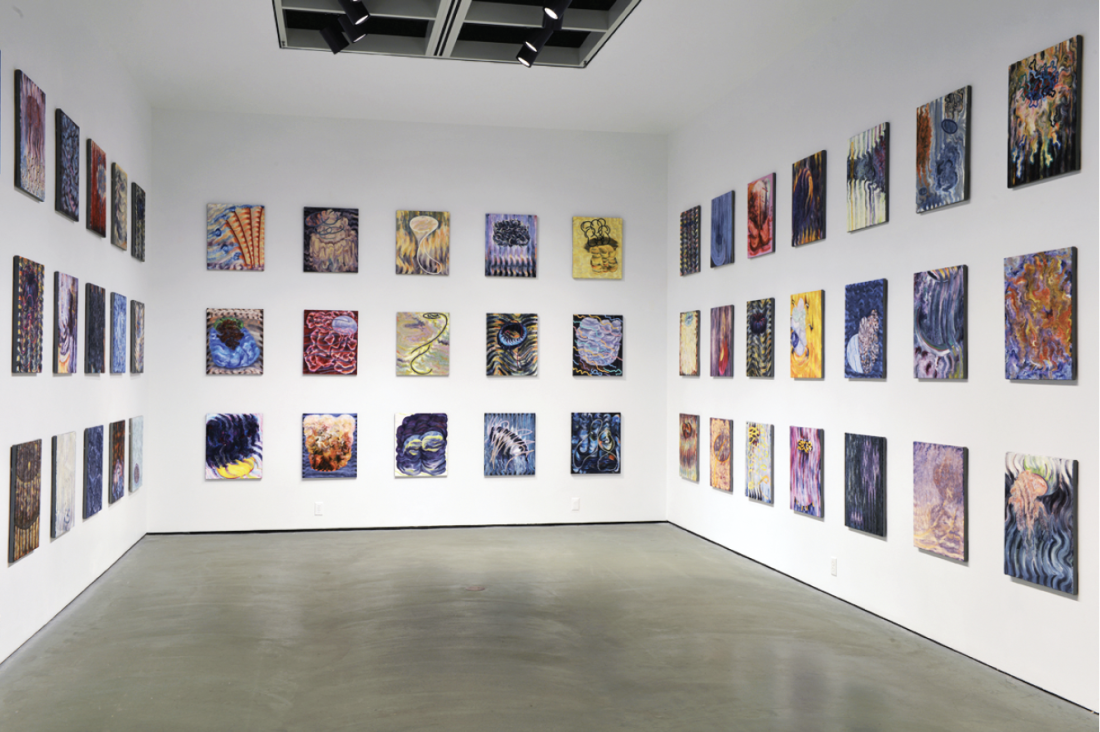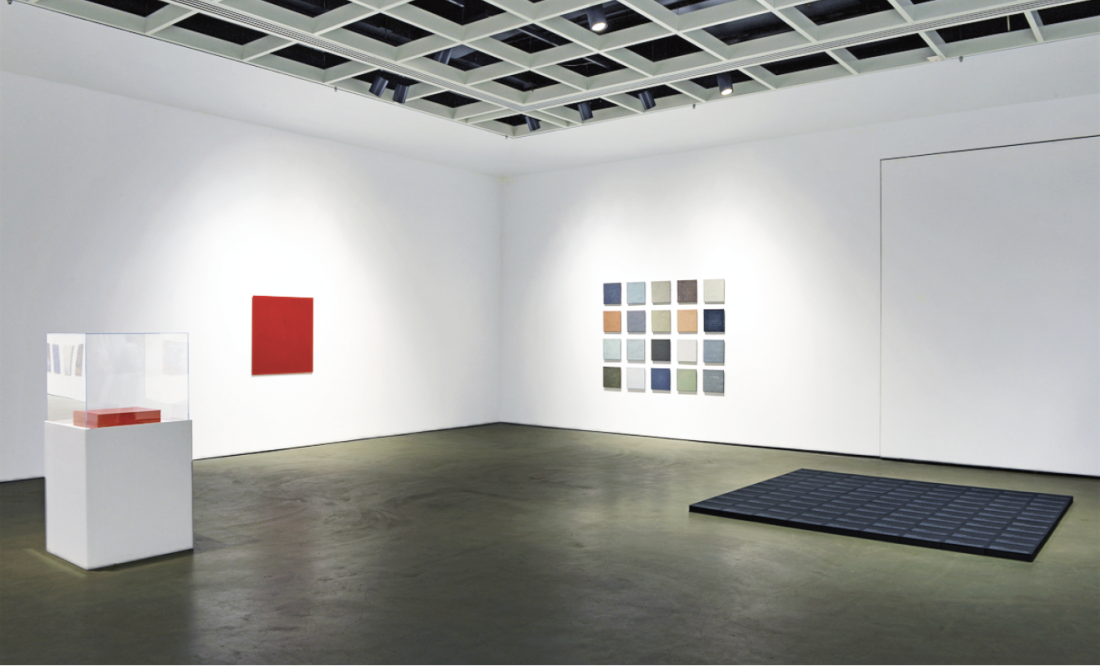Gary Spearin
The dialogue created between Gary Spearin’s installation, “iNifiNiTi,” at McMaster Museum of Art, and “PAINTING BEYOND a body of views,” the artist’s ‘orchestration’ of his paintings with works from the museum’s collection, focuses on the visual perception of time and place in contemporary art. “iNifiNiTi,” composed of eighty-six 24- by 20-inch paintings arranged in a continuous grid around the gallery, immerses viewers in a dizzying expanse of intense colour. In this ambitious ongoing project, Spearin envisages time through the physical sensation of oil paint on canvas. Intuitive and intellectual, spontaneous and controlled, these canvases traverse a painting discourse that pulsates uneasily between the poles of expressionistic abstraction and postmodern Conceptualism. While the previous “iNifiNiTi” installation at Museum London dwarfed viewers with its gridded expanse of paintings stretching 20 feet up to the gallery’s skylight above, here we engage the work at close range. The sumptuous optical excess is unsettling, yet the conversation sparked between canvases is compelling, and individual paintings demand attention. Densely worked surfaces of thickly textured paint, in sinuous dragged and brushed patterns, collapse figure and ground in an apparently effortless play with space. Semi-recognizable organic forms float within ribbons of colour in looping, entangled formations. Each painting hovers between illusion and abstraction. The ever-growing installation continually morphs, the indexing of time as subject becoming an obsession with limitless possibilities. The paintings’ random numerical calendar-date titles become fictitious markers of time that is past and is to come, a strategy tempting free association. Viewing “iNifiNiTi” becomes a bodily experience. We are sucked in by the luxuriant palette, jarring moments of discord and perception of being surrounded by time poetically reinventing itself, in a plane beyond the material realm.

Gary Spearin, “iNifiNiTi” (detail), 2007–2012 (ongoing), oil on canvas, 87 paintings, each 60.96 x 50.8 cm. Installation dimensions variable. Photograph: Gerard Pas. Images courtesy of the artist.
In the adjoining gallery, we remain acutely aware of dualities marking Spearin’s practice, and of its conceptual strength. Here he places his “Grey Paintings” alongside works by significant contemporary artists with whom his ideas resonate. Playing on masking and revealing, presence and absence, he carefully positions each work to propose aesthetic and conceptual associations. In contrast to the “iNifiNiTi” installation, the gallery becomes a spatial canvas mediating experience rather than inviting a visceral response. Works are united by a shared desire for a meta-narrative that lies beyond the visible. The sightline from one gallery to the next reveals Art & Language’s painting, showing views through the Whitney Museum (Index: Incident in a Museum III, 1985), to provide a repeating configuration of framing architecture that literally recedes into the collaged canvas. Next to this, Richard Hamilton’s painted photographic collage, Northend 1, 1990, continues this play on views through interior spaces, a painted vertical grey stripe on the left anchoring the composition in our space. Across the room, Gerhard Richter’s Mirror, Blood Red, 736-8, 1991, reflects gallery and viewers in its glazed pool of infinite red. Marcel Duchamp’s boite-en-valise, 1966–67, a red case on a plinth nearby, is purposefully displayed closed in order to echo this deep red square while secreting the artist’s retrospective folio, a ready-made surrogate for the experience of viewing his work. On the floor across from this, Alfredo Jaar’s Benjamin, 1995, is laid out in a grid—99 archival boxes concealing photos of Rwanda’s genocide, their surface text describing the contents. In close proximity, Spearin has placed his Toronto Riots, 2010, a grid of 20 square canvases painted from photographs documenting this event. Unlike “iNifiNiTi’s” turbulent painterliness, these works systematically combine quantified colours from each photo into one muted hue for each canvas. Lastly, Spearin juxtaposes Leon Kossoff’s landscape Between Kilburn and Willesden Green, 1993, which paradoxically freezes a speeding train’s fleeting movement in a thickly encrusted block of paint, with his painting, White Flag, 2012, where he blurs a world map’s geopolitical borders by first quantifying and combining the colours of national flags and then dragging resulting monochromatic hues across a white ground.

Installation view of Gary Spearin’s “PAINTING BEYOND a body of views.” Left to right: Marcel Duchamp, Boîte-en-valise, Series F, 1966–67 mixed media in red leather covered case, dimensions closed: 9.9 x 41.5 x 38.5 cm; Gerhard Richter, Spiegel Blutrot/Mirror, Blood Red, 736-8, 1991 pigment on glass, 95 x 86 cm; Gary Spearin, Toronto Riots, 2010, 20 paintings, oil on canvas, each 30.5 x 30.5 cm; Alfredo Jaar, Benjamin, 1995, 99 linen boxes with text and cibachrome photographs, 5.1 x 269.9 x 251.5 cm. Photograph: Gerard Pas.
Spearin states his “role as an artist is to make what is invisible visible; to make something visible that summons the invisible.” These exhibitions present infinite possibilities of interpreting experience (direct and mediated, personal and public) through our field of vision, and stimulate reflection on the role of memory and how representation functions. Spearin’s paintings fluctuate between the past and future, the here and there. The oscillation occurring between the “iNifiNiTi” paintings and “Grey Paintings” strongly suggests a meta-modern sensibility. Though formally he employs a modernist grid structure, his work refuses easy categorization through its vacillation between seemingly incompatible extremes: painting as a performative expressionist language based on chance and control, and the use of systematic processes governed by an overarching cerebral engagement with subject. His work’s sincerity, however, exposes its meta-modernist core. His paintings reveal the pure enjoyment of creating an immersive aesthetic experience that stimulates thought and transports viewers into an imagined space. His evident passion, smart cura–torial choices and prudent spatial choreographing of these works make viewing these exhibitions a satisfying experience. As the exhibition titles imply, we step into an infinite space…a space of “painting beyond.” ❚
“iNifiNiTi” and “PAINTING BEYOND a body of views” were exhibited at the McMaster Museum of Art, Hamilton, from May 12 to August 18, 2012.
Joscelyn Gardner is a visual artist who exhibits internationally and works between Canada and the Caribbean.

